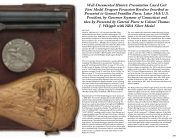Page 195 - 4094-BOOK2
P. 195
193
LOT 1202
Serial no. 3969, 44 cal., 7 1/2 inch part round bbl., blue/
casehardened/silver finish, varnished walnut grips. This
historic revolver from 1848 features an incredibly rare double
presentation inscription on the back strap reading: “Presented
by Col. Seymour; Gov. of Conn. to Genl/Franklin Pierce, & by
him Presented to Thos. J. Whipple.” The inscription connects
to three powerful and influential men within the Democratic
Party in New England in the mid-19th century who all
served in the 9th U.S. Infantry Regiment during the Mexican-
American War and all practiced law. Pierce of course famously
went on to be elected the 14th President of the United States
of America, and Colonel Whipple fought again during the
Civil War.
This iconic revolver has been featured in several publications,
including “The William M. Locke Collection” by Sellers on
page 48, “Colt Engraving” by Wilson on page 27, “Fine Colts:
The Dr. Joseph A. Murphy Collection” by Wilson on pages 18
and 19, “Colt Single Action: From Paterson to Peacemaker”
by Adler on pages 72 and 73, and “Guns of the Civil War” by
Adler on page 27. The set was awarded a silver medallion
for one of the 10 best of show guns by the NRA (medal
included). Collector Greg Lampe wrote that this revolver is
“one of the most historically important Colt revolvers” and
“the only presidential presentation known” on top of being
“the finest civilian First model Dragoon in existence.” It truly
is an exceptional and fascinating example of Colt’s powerful
antebellum era “holster pistol.” Very few presentation Dragoon
revolvers were made, especially compared to Colt’s Model
1851 Navy “belt pistols” and Model 1849 Pocket revolvers.
Approximately 7,000 First Model Dragoons were produced
c. 1848-1850. The revolver displays this model’s distinct oval
cylinder stops and squareback trigger guard as well as the
V-shaped mainspring and hammer without a bearing. The
barrel has a German silver blade front sight and “{ADDRESS
SAML COLT NEW-YORK CITY}” marked on top reading
from the breech towards the muzzle. The cylinder has the
rarer “U.S. DRAGOONS” marking along with the standard
“COLT’S PATENT” markings and the classic Texas Ranger and
Comanche battle scene. The left side of the frame is marked
“COLT’S/PATENT/U.S”, and matching serial numbers are visible
on the cylinder, loading lever, barrel, frame, trigger guard,
and back strap. The latter features the historical inscription
noted above, and it and the trigger guard are silver plated
while the cylinder and barrel are blued, and the remaining
metal surfaces are casehardened. The one-piece walnut grip
has a varnished finish. The revolver comes in a very distinctive
leather bound case fitted in the early style similar to Colt’s
Paterson revolvers.
The case contains the distinctive combination tool, a brass
ball and bullet mold with sprue cutter and “COLTS/PATENT”
marked on the side, and First Model Dragoon powder flask.
The combination tool was once separated from the set while
in the Dr. Joseph A. Murphy Collection but was returned to
the set by Greg Lampe as explained in the detailed research
and provenance binder that accompanies the set. He
acquired it with another revolver from Murphy’s collection.
The revolver is accompanied by an extensive research file
as well as carte-de-visites of Pierce and Whipple and a copy
of “The Illustrated Laconian.”The inscription indicates the
revolver was first presented by Democratic Governor Thomas
H. Seymour (1807-1868, in office 1850-1853) of Connecticut
to General Franklin Pierce (1804-1869). Seymour, a Hartford,
Connecticut, native, was an ally of Samuel Colt. He studied
at the Middletown Military Academy and then law and
became a lawyer in Hartford in the 1830s and then a probate
judge as well as the editor of the Jeffersonian. He served in
the U.S. House of Representatives in 1843-1845 and did not
run for re-election. Pierce was also a lawyer by trade and
quickly moved up the ranks in state and federal politics as a
New Hampshire state representative from 1829-1833, state
speaker of the house in 1831-1833, congressman in 1833-
1837, and senator in 1837-1842. He took particular interest in
military matters.
The Mexican-American War brought all three men that owned
this revolver together. The United States Congress authorized
additional regiments for the U.S. Army, including the 9th U.S.
Infantry, sometimes known as the New England regiment.
Pierce served as the unit’s colonel, Seymour served as a
major, and fellow New Hampshire lawyer Thomas Jefferson
Whipple (1816-1889) served as Pierce’s adjutant. Whipple
had been educated at the Norwich Military University and
previously served as an aid-de-camp to General Cook in
the New Hampshire militia and formed the Wentworth
Phalanx. During the war, he was captured at Vera Cruz much
to the alarm of Colonel Pierce who wrote of the event in his
journal: “July 8. Lieutenant T. J. Whipple, adjutant of the Ninth
Infantry, was induced by curiosity to visit, with private Barnes
of Manchester, the cemetery near the wall of the city - an
imprudent act, especially as the audacity of the guerrillas, and
their daily near approach, have been well understood. That he
should have gone with a single unarmed private, and himself
without arms except his sabre, is astonishing. Lieutenant
Whipple was attacked by six guerrillas, and overpowered.
Well-Documented Historic Presentation Cased Colt
First Model Dragoon Percussion Revolver Inscribed as
Presented to General Franklin Pierce, Later 14th U.S.
President, by Governor Seymour of Connecticut and
then by Presented by General Pierce to Colonel Thomas
J. Whipple with NRA Silver Medal

